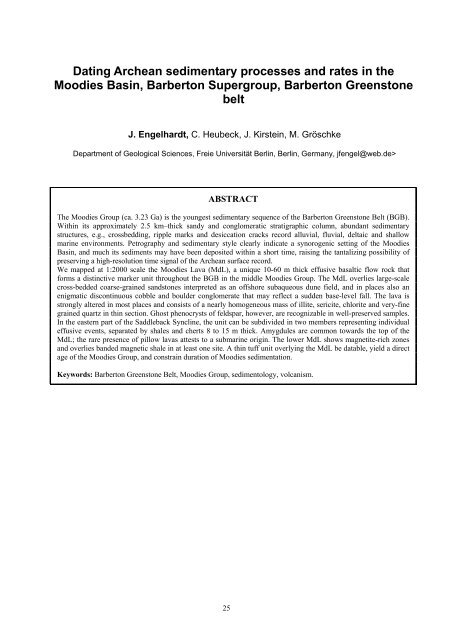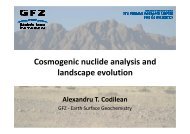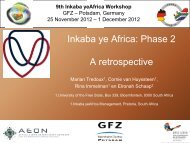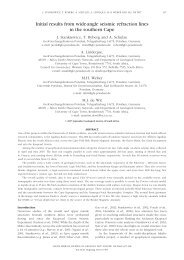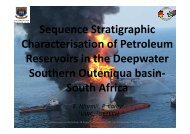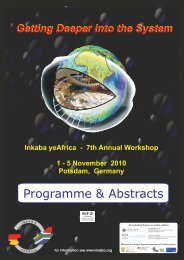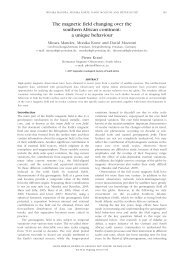South Africa - Inkaba.org
South Africa - Inkaba.org
South Africa - Inkaba.org
Create successful ePaper yourself
Turn your PDF publications into a flip-book with our unique Google optimized e-Paper software.
Dating Archean sedimentary processes and rates in the<br />
Moodies Basin, Barberton Supergroup, Barberton Greenstone<br />
belt<br />
J. Engelhardt, C. Heubeck, J. Kirstein, M. Gröschke<br />
Department of Geological Sciences, Freie Universität Berlin, Berlin, Germany, jfengel@web.de><br />
ABSTRACT<br />
The Moodies Group (ca. 3.23 Ga) is the youngest sedimentary sequence of the Barberton Greenstone Belt (BGB).<br />
Within its approximately 2.5 km–thick sandy and conglomeratic stratigraphic column, abundant sedimentary<br />
structures, e.g., crossbedding, ripple marks and desiccation cracks record alluvial, fluvial, deltaic and shallow<br />
marine environments. Petrography and sedimentary style clearly indicate a synorogenic setting of the Moodies<br />
Basin, and much its sediments may have been deposited within a short time, raising the tantalizing possibility of<br />
preserving a high-resolution time signal of the Archean surface record.<br />
We mapped at 1:2000 scale the Moodies Lava (MdL), a unique 10-60 m thick effusive basaltic flow rock that<br />
forms a distinctive marker unit throughout the BGB in the middle Moodies Group. The MdL overlies large-scale<br />
cross-bedded coarse-grained sandstones interpreted as an offshore subaqueous dune field, and in places also an<br />
enigmatic discontinuous cobble and boulder conglomerate that may reflect a sudden base-level fall. The lava is<br />
strongly altered in most places and consists of a nearly homogeneous mass of illite, sericite, chlorite and very-fine<br />
grained quartz in thin section. Ghost phenocrysts of feldspar, however, are recognizable in well-preserved samples.<br />
In the eastern part of the Saddleback Syncline, the unit can be subdivided in two members representing individual<br />
effusive events, separated by shales and cherts 8 to 15 m thick. Amygdules are common towards the top of the<br />
MdL; the rare presence of pillow lavas attests to a submarine origin. The lower MdL shows magnetite-rich zones<br />
and overlies banded magnetic shale in at least one site. A thin tuff unit overlying the MdL be datable, yield a direct<br />
age of the Moodies Group, and constrain duration of Moodies sedimentation.<br />
Keywords: Barberton Greenstone Belt, Moodies Group, sedimentology, volcanism.<br />
25


